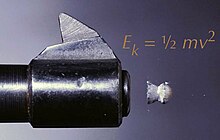This articleneeds additional citations forverification.(December 2009) |
Muzzle energyis thekinetic energyof abulletas it is expelled from themuzzleof a firearm. Without consideration of factors such as aerodynamics and gravity for the sake of comparison, muzzle energy is used as a rough indication of the destructive potential of a given firearm or cartridge. The heavier the bullet and especially thefaster it moves,the higher its muzzle energy and the more damage it will do.

Kinetic energy
editThe general formula for the kinetic energy is wherevis thevelocityof the bullet andmis themassof the bullet.
Although both mass and velocity contribute to the muzzle energy, the muzzle energy is proportional to the mass while proportional to thesquareof the velocity. The velocity of the bullet is a more important determinant of muzzle energy. For a constant velocity, if the mass is doubled, the energy is doubled; however, for a constant mass, if the velocity is doubled, the muzzle energy increasesfourtimes. In theSI systemthe aboveEkwill be in unitjoulesif the mass,m,is inkilograms,and the speed,v,is inmetres per second.[1]
Typical muzzle energies of common firearms and cartridges
editMuzzle energy is dependent upon the factors previously listed, and velocity is highly variable depending upon the length of the barrel a projectile is fired from.[2]Also the muzzle energy is only an upper limit for how much energy is transmitted to the target, and the effects of aballistic traumadepend on several other factors as well. There is wide variation in commercial ammunition. A 180 gr (12 g) bullet fired from.357 Magnumhandgun can achieve a muzzle energy of 580 ft⋅lbf (790 J). A 110 gr (7.1 g) bullet fired from the same gun might only achieve 400 ft⋅lbf (540 J) of muzzle energy, depending upon the manufacturer of the cartridge. Some.45 Colt +Pammunition can produce 1,200 ft⋅lbf (1,600 J) of muzzle energy.[citation needed]
Legal requirements on muzzle energy
editMany parts of the world use muzzle energy to classify guns into categories that require different categories of licence. In general guns that have the potential to be more dangerous have tighter controls, while those of minimal energy, such as small air pistols or air rifles, require little more than user registration, or in some countries have no restrictions at all.Overview of gun laws by nationindicates the various approaches taken.Firearms regulation in the United Kingdomis a complicated example, but is demarked by muzzle energy as well as barrel length and ammunition diameter.
Some jurisdictions also stipulateminimummuzzle energies for safe hunting. For example, inDenmarkrifle ammunition used for hunting the largest types of game there such asred deermust have a kinetic energyE100(i.e.: at 100 m (110 yd) range) of at least 2,700 J (2,000 ft⋅lbf) and a bullet mass of at least 9 g (140 gr) or alternatively anE100of at least 2,000 J (1,500 ft⋅lbf) and a bullet mass of at least 10 g (150 gr).[3]Namibiaspecifies three levels of minimum muzzle energy for hunting depending on the size of the game, 1,350 J (1,000 ft⋅lbf) for game such asspringbok,2,700 J (2,000 ft⋅lbf) for game such ashartebeest,and 5,400 J (4,000 ft⋅lbf) forBig Five game,together with a minimum caliber of 7 mm (0.28 in).[4]
InGermany,airsoft gunswith a muzzle energy of no more than 0.5 J (0.37 ft⋅lbf) are exempt from thegun law,[5]whileair gunswith a muzzle energy of no more than 7.5 J (5.5 ft⋅lbf) may be acquired without afirearms license.[6]
Mainland Chinauses a varied concept of "muzzle ratio kinetic energy"(Chinese:Họng súng so động năng), which is thequotient(ratio) of the muzzle energydividedby theborecross sectional area,to distinguish genuine guns from "imitation"replicasliketoy guns.TheMinistry of Public Securityunilaterally introduced the concept in 2008 leading up to theBeijing Olympic Games,dictating that anything over 1.8 J/cm2to be defined as real firearms. This caused many existing toy gun products on the Chinese market (particularlyairsoft) tobecome illegalovernight, as almost allairsoft gunsshooting a standard 0.20 g (3.1 gr)6 mm (0.24 in) pellethave amuzzle velocityover 76 m/s (250 ft/s), which translates to more than 0.58 J (0.43 ft⋅lbf) of muzzle energy, or 2.0536 J/cm2of "ratio energy". For comparison astandard baseballchangeupthrown at 34 m/s (110 ft/s) has 1.951 J/cm2of "ratio energy" which also exceeds the 1.8 J/cm2of a real firearm while afastballcan reach over 3.5 J/cm2or nearly double the level of a real firearm. The subsequent crackdowns bylocal law enforcementled to many seizures, arrests and prosecutions of individual owners for "trafficking and possession of illegal weapons" over the years for weapons that were previously permitted.
See also
editResources
edit- Edward F. Obert,Thermodynamics,McGraw-Hill Book Co., 1948.
- Mc Graw-Hill encyclopedia of Science and Technology, volume ebe-eye and ice-lev, 9th Edition, Mc Graw-Hill, 2002.
References
edit- ^Beer, Ferdinand P.; Johnston, E. Russell Jr; Cornwell, Phillip J. (2013).Vector Mechanics for Engineers(10th ed.). New York, NY: McGraw-Hill. p. 768.ISBN978-0-07-740232-7.
- ^"BBTI - Ballistics by the Inch - Home".ballisticsbytheinch.[better source needed]
- ^"Bekendtgørelse om skydevåben og ammunition, der må anvendes til jagt m.v."[Hunting weapons and ammunition act].retsinformation.dk(in Danish).Miljøministeriet.2012-12-17. Ammunition.Retrieved2015-03-10.
- ^"NAPHA - Namibia Professional Hunting Assiation: Hunting Laws& Rifle Importation".napha-namibia.Retrieved5 July2015.
- ^"Ab welcher Geschossenergie fallen Soft-Air-Waffen unter das Waffengesetz?"[From which muzzle energy does Airsoft guns fall under the gun law?].bmi.bund.de(in German). Archived fromthe originalon 2016-03-04.Retrieved2015-09-17.
- ^"Waffengesetz (WaffG)"[gun law].gesetze-im-internet.de(in German).Retrieved2015-09-19.